New Boston Historical Society
New Boston, New Hampshire

Photographer in front of Baptist Church and Town Hall
Photography in New Boston — Part 1
How often do you see a photograph of a photographer? He or she usually stands behind the camera, not in front of it. The unique photo at the top of this page shows a photographer outside the Baptist Church near New Boston Town Hall. He is one of many people who have documented New Boston history with their cameras.We don't know the man's name, or exactly when the photograph was taken, although we'll guess it was wintertime! The church was built in 1889 and torn down in 1944, and today there is a gazebo on that spot.
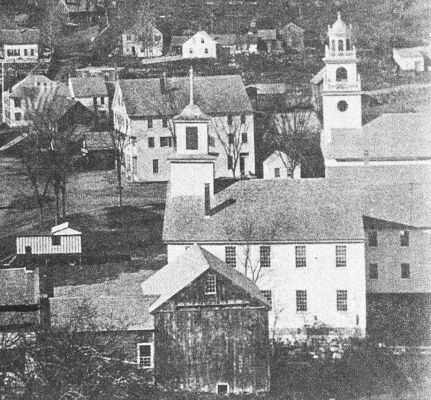
We examined this photograph closely because most of the buildings in the photo burned in the Fire of 1887, so this is one of the few images we have of the town before that terrible conflagration. What puzzled us was the small structure on wheels, white with vertical stripes, parked in front of the Town Hall. What could it be? (Make your best guess before scrolling down.)
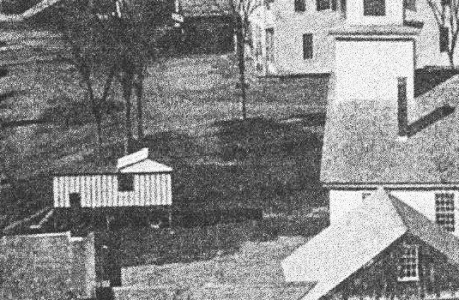
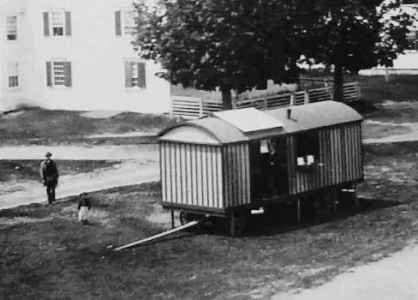
Details of photos from New Boston (left) and Goffstown (right)
Among the quaint objects that were to be seen in New England fifty years ago, few were more interesting than the itinerant "daguerreotype saloon" - those peripatetic studios on wheels, in which artists used to journey about the country taking photographs. Of course, card photographs had not come into vogue then; but there were the daguerreotypes, and later the tintypes, and finally the ambrotypes in little black-and-gilt cases. Those "saloons" were picturesque little structures, not much more than five feet wide by fifteen feet long; they were mounted on wheels. On each side was a little window, and overhead was a larger skylight; a flight of three steps led up to a narrow door at the rear. The door opened into the "saloon" proper, where the camera and the visitor's chair stood; forward of that was the cuddy under the skylight, in which the photographer did his developing.We wonder how many pictures of old New Boston and portraits of its citizens were made in mobile darkrooms like the "daguerreotype saloon".
The photographer was usually some ambitious young fellow who, after learning his trade, often made and painted his "saloon" himself. Frequently he slept in it, and sometimes cooked his meals in it. If he did not own a horse, he usually made a bargain with some farmer to haul him to his next stopping place in exchange for taking his picture. When business grew dull in one neighborhood, he moved to another.
Daguerrotypes, ambrotypes and tintypes
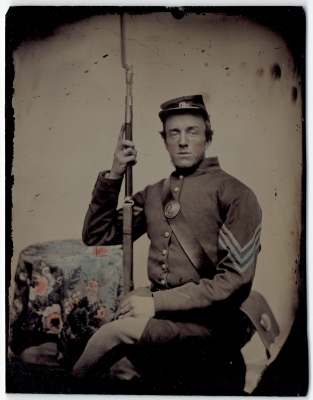

Sgt. Jacob Langdell of New Boston (left) and another soldier
 Among the oldest New Boston photos in our collection are hand-colored portraits
from the Civil War era (1861-1865)
of Jacob Langdell and another soldier, who may or may not be Jacob.
Jacob-on-the-left wears a sergeant's stripes; the other soldier does not.
Among the oldest New Boston photos in our collection are hand-colored portraits
from the Civil War era (1861-1865)
of Jacob Langdell and another soldier, who may or may not be Jacob.
Jacob-on-the-left wears a sergeant's stripes; the other soldier does not.
The photograph of Sgt. Jacob Langdell is called an "ambrotype". The earliest photographs were "daguerrotypes", in which a light-sensitive material was applied to a silver-coated copper plate. "Ambrotypes" made on glass plates were popular from 1854 through the 1860s, and they were succeeded by "tintypes" which were made on thin metal plates (iron; not actually tin).
If you have a photograph mounted behind glass in an ornate metal case, like the unidentified soldier's portrait above, it can be difficult to tell if it's a daguerrotype, an ambrotype or a tintype. Sergeant Langdell's photo is unmounted, and we can shine a light through it. When held up to a bright light, Jacob's black & white portrait turns red (left) which means that it's a "ruby ambrotype", named after the reddish-colored glass on which the photograph was made.
All three technologies - daguerrotype, ambrotype, and tintype - reverse the image which is why the soldiers' uniforms appear to be buttoned backwards.

1890s(?) tintype of the post office
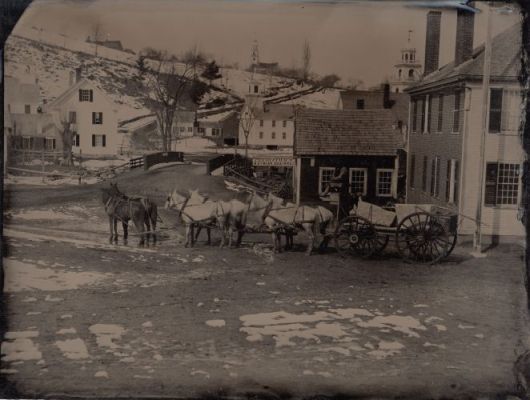
1860s(?) tintype of a wagon with a load of soapstone from Francestown
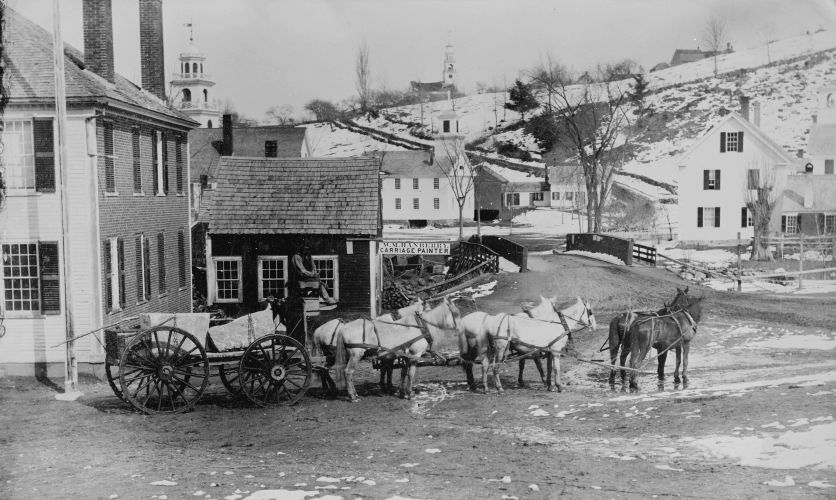
The same tintype, flipped horizontally and brightened
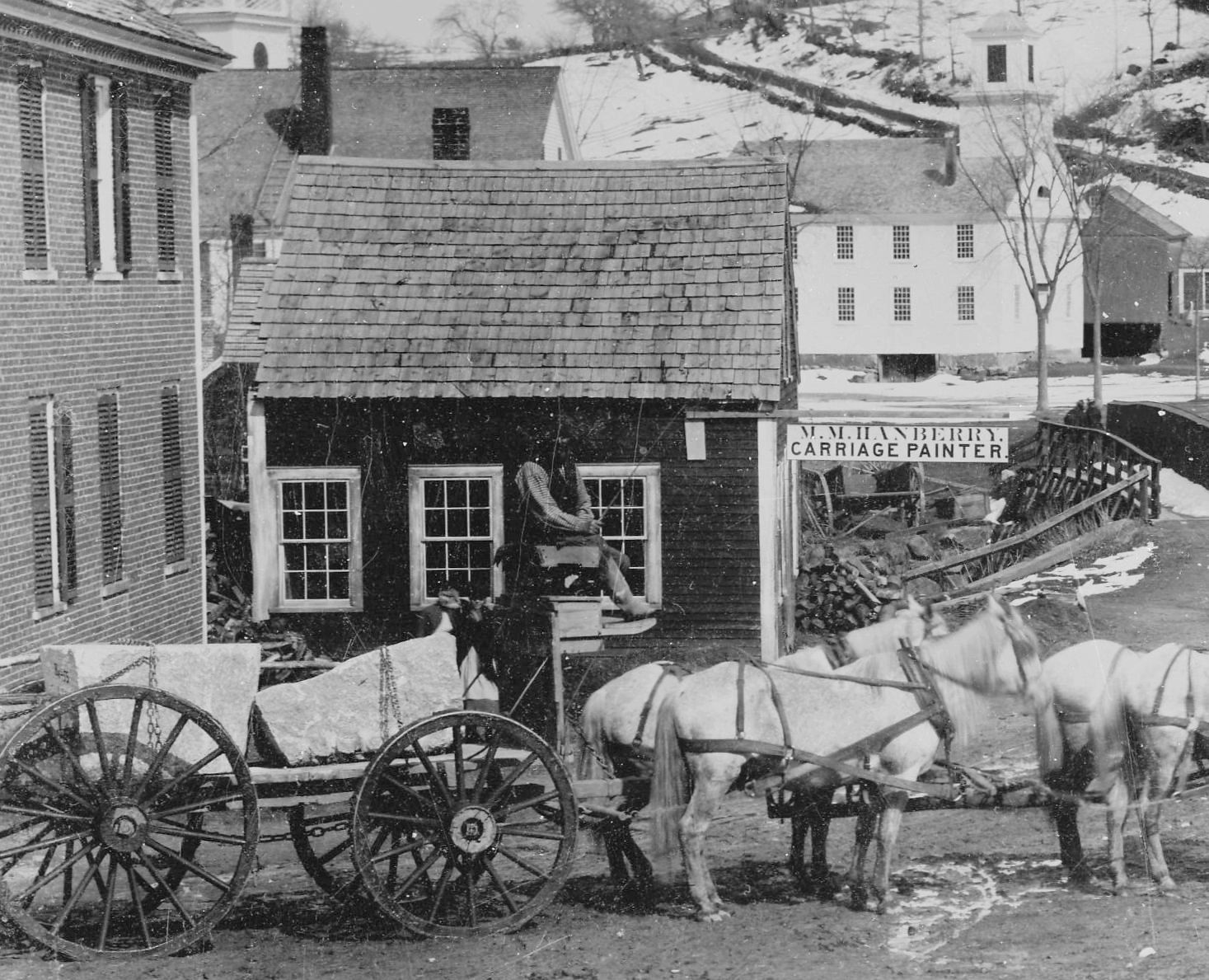
Enlarged to show detail
Glass negatives like the one below provide very good detail. The resolution of this 5"x8" glass negative is limited by modern technology: our digital camera and image resizing for this web page.

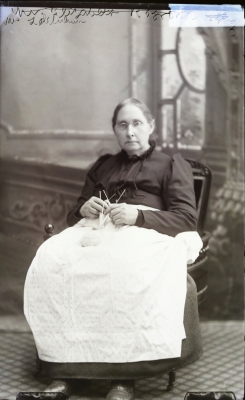
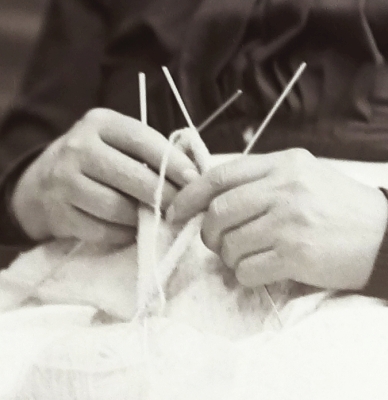
Hannah Eastman Story (1820-1911), wife of Luther Colburn, posed for a formal portrait
then asked the photographer to take this less-formal picture.
Three views of a photo of Hannah knitting: glass negative, positive, and a close-up.
(Gift of Steven Foley and Bonnie Champagne)
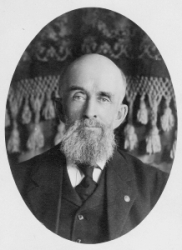
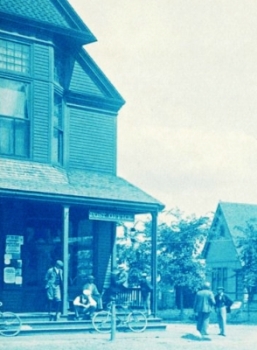 Paper or Plastic?
Paper or Plastic?Not all photographs are made on glass or metal. Photographs printed on paper appeared even before the tintype was invented. These "black and white" photographs were typically printed in shades of gray, like the portrait of a much older Sgt. Jacob Langdell (left), or sepia, which is a brownish color.
We also have some photos printed in shades of blue (right). These are "cyanotypes" which were made using a chemical process also used to create blueprints. One photo album featured in our New Boston in 1899 page contains many interesting photos, all in blue.
We don't know who made our 1899 album, but a likely suspect is a talented photographer named Myrtie May Atwood, daughter of Solomon and Florence Atwood. The Historical Society has a collection of 70 glass plate negatives made by Myrtie in the 1890s, similar in theme and composition to the 1899 album. Myrtie later married George Henry Eastman of Weare, NH.
Also in the 1890s, a completely different George Eastman developed a flexible celluloid film for photography that was 35mm wide, and he later founded the Eastman Kodak company. This coincidence (the two George Eastmans were unrelated, as far as we know) will provide us an excuse to leap forward into the 20th century and talk about color slides.
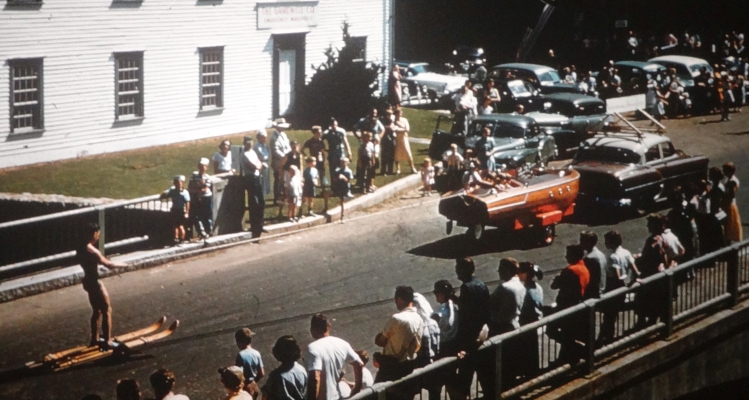 border="1" style="max-width:100%;height:auto;">
border="1" style="max-width:100%;height:auto;">
Color slide of 4th of July parade - New Boston 1955
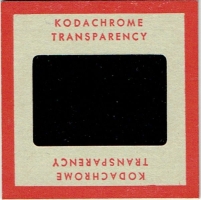 The Historical Society received a gift from Barbara Mace of a wooden box containing color slides dated 1955, 1956, 1960 and 1964.
All the slides were of New Boston 4th of July parades.
We found an old Kodak Carousel projector, set up our screen, loaded up the slides, and turned out the lights.
To our surprise the projector bulb still worked, and we were transported into the past.
The colors were a little faded, but it was fun to see what New Boston looked like 60 years ago, how people dressed,
and the parade floats towed by shiny convertibles.
The Historical Society received a gift from Barbara Mace of a wooden box containing color slides dated 1955, 1956, 1960 and 1964.
All the slides were of New Boston 4th of July parades.
We found an old Kodak Carousel projector, set up our screen, loaded up the slides, and turned out the lights.
To our surprise the projector bulb still worked, and we were transported into the past.
The colors were a little faded, but it was fun to see what New Boston looked like 60 years ago, how people dressed,
and the parade floats towed by shiny convertibles.
In 2016, not too long after another exciting Fourth of July, we invited everyone to the Community Church to see the slide show. About 75 people came, and we took notes as quickly as we could as people identified who was who in the old photos. The family of Herbert "Bib" Elliott was surprised to see Bib water-skiing through town towed behind a polished wood speedboat, as in the photo above.
The Problem with Old Photographs
The Historical Society has hundreds of UFOs - Unidentified Fotographic Objects. We have boxes and boxes full of unlabeled photographs!
As we look at each photograph, we wonder: Who are those people smiling at the camera? (Actually, nobody smiles in old photos.) When and where was the picture taken? Wouldn't someone love to see photos of their great-grandparents?
We have two urgent requests of you:
1. Please go right now to that dusty shoebox on the top shelf of your closet and label the photos! Get help from your oldest relatives, and write down their stories, too. Family Tree magazine has helpful information about Safely Labeling Your Old Family Photos. Several other sources recommend a Sakura 30581 Pigma Micron 05 Ink Pen.
2. If you're one of those people who takes hundreds of pictures on your iPhone and posts them to Facebook, Instagram or Snapchat, think about printing (and labeling) the best of them so that future generations and historical societies will have something to work with!
Part 2 of this two-part series describes Photography in New Boston in the 21st Century.
